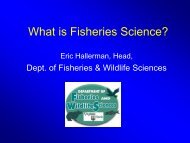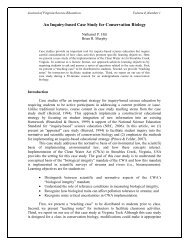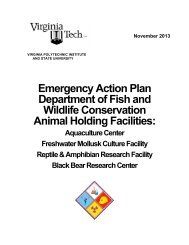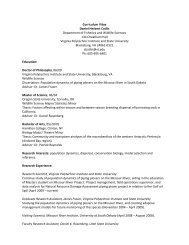342 THE AMERICAN MIDLAND NATURALIST 163(2)FIG. 3.—Protracted excystment <strong>of</strong> juveniles <strong>of</strong> Lemiox rimosus from greenside (n 5 5) <strong>and</strong> b<strong>and</strong>ed (n 515) darters. Glochidia were infested on these hosts in the fall <strong>of</strong> the year (Nov.) (see Table 3 for details)rare in the population (Fig. 5). Older individuals likely exist in the population, but theiroccurrence is seemingly uncommon <strong>and</strong> not detected in this limited sample. Thepredominance <strong>of</strong> younger individuals indicates that the population has been recruitingin the last 5 y. In the Clinch <strong>and</strong> Duck rivers respectively, sex ratio was 2:1 <strong>and</strong> 3:1 in favor <strong>of</strong>males.Densities <strong>of</strong> Lemiox rimosus in the Clinch River, TN, were at constant but low levels <strong>of</strong>#0.3 m 22 from 1979–2004 (Fig. 6). Based on data collected annually by systematic surveys atfour sites from 2004–2007, densities were at similar levels, <strong>and</strong> corresponding populationsizes ranged from 210 to 4003 individuals/site (Table 5). By comparison, densities in theDuck River, TN, were at higher levels, ranging from 0.57 to 6.0 m 22 from 1979–2004, with asignificant (P 5 0.011) increase observed from 1988 to 2004 (Fig. 6). However, based ondata collected by systematic surveys at three sites from 2004–2006, to include Lillard Mill,reported densities were lower <strong>and</strong> ranged from 0.6 to 1.0 m 22 ; corresponding populationsizes were from 2925 to 29,400 individuals/site (Table 5).DISCUSSIONMussel-host fish interactions <strong>and</strong> life history.—Previous host tests conducted by Hill (1986)<strong>and</strong> Watson (1999) found that several darter species served as suitable hosts for theglochidia <strong>of</strong> L. rimosus <strong>and</strong> that other families, including minnows (cyprinids), suckers(catostomids), <strong>and</strong> catfishes (ictalurids), were unsuitable hosts. Based on juveniletransformation success <strong>of</strong> previous studies <strong>and</strong> ours, the primary natural fish hosts arelikely Etheostoma blennioides, E. simoterum <strong>and</strong> E. zonale. These darters are morphologicallysimilar <strong>and</strong> phylogenetically related [all in the subgenus Ulocentra, Porter et al. (2002)], withthe former two species known to feed on snails ( Jenkins <strong>and</strong> Burkhead, 1994). However, aweakness <strong>of</strong> this study is that fish host tests were conducted using fish species from only the
2010 JONES ET AL.: BIRDWING PEARLYMUSSEL LIFE HISTORY AND DEMOGRAPHY 343upper Tennessee River drainage. Thus, additional trials using fish from the Duck River <strong>and</strong>other streams could reveal additional suitable hosts.The thick cartilaginous lips <strong>and</strong> jaw structure <strong>of</strong> Etheostoma blennioides may be adapted t<strong>of</strong>eeding on snails (Jenkins <strong>and</strong> Burkhead, 1994). During fish host trials, fish were fed adultsizedsnail species in the genera Leptoxis <strong>and</strong> Elimia, <strong>and</strong> their feeding behavior directlyobserved. A darter would quickly take a snail in its mouth, turn it to hold the operculumend, <strong>and</strong> then suck the s<strong>of</strong>t-body <strong>of</strong> the snail out <strong>of</strong> the shell, all in a matter <strong>of</strong> seconds. Inaddition, by supplementing its diet with snails while in captivity, its condition <strong>and</strong> survivalimproved, suggesting a preference <strong>and</strong> specialization for feeding on snails. Thus, host-usageby Lemiox rimosus seems to be relatively specific, as transformation success on other darterspecies i.e., E. rufilineatum <strong>and</strong> E. camurum which belong to the subgenus Nothonotus,generally was poor (Table 3). To our knowledge, L. rimosus is the only unionid that has amantle-lure display that mimics a freshwater snail.Since females <strong>of</strong> Lemiox rimosus were observed displaying in the fall, it is likely that someglochidia are released <strong>and</strong> attach to host fishes during this season. Our fish host resultsshowed that juvenile excystment was protracted for trials conducted in the fall. This delayedexcystment possibly indicates that glochidia were not completely mature. For example,immature glochidia have been observed in the fall in several other lampsiline musselspecies, including Cyprogenia stegaria, Dromus dromas <strong>and</strong> Epioblasma capsaeformis ( Jones <strong>and</strong>Neves, 2002; Jones et al., 2004, 2005). Why would a female display <strong>and</strong> release glochidia inthe fall that are not completely mature? Do the glochidia continue to mature while they areencysted <strong>and</strong> over-winter on their host? Over-wintering <strong>of</strong> glochidia on host fishes alreadyhas been documented in Lampsilis cardium <strong>and</strong> other species (see Watters <strong>and</strong> O’Dee, 1999<strong>and</strong> references therein), <strong>and</strong> presents an intriguing possibility for L. rimosus. Watters <strong>and</strong>O’Dee (1999) have shown that prolonged, cold water temperature (e.g., ,10 C) was likelythe controlling mechanism allowing for delayed excystment <strong>and</strong> over-wintering on host fish.We suggest that larval maturity may play a role as well, allowing glochidia to delaymetamorphosis, then excyst <strong>and</strong> settle during better growing conditions in the spring tomaximize 1st year growth.Age <strong>and</strong> growth.—Although maximum age recorded for Lemiox rimosus was 15 y, it ispossible that older animals may occur in both populations. However, locating olderindividuals in mussel populations is difficult due to their rarity. The predicted growthincrements <strong>and</strong> k-values in the Duck River population were higher than those in the ClinchRiver population. Biologists have long recognized the greater shell growth <strong>and</strong> productivity<strong>of</strong> mussels in the Duck River compared to other rivers in the Tennessee River system(Ortmann, 1924). The headwaters originate in the Highl<strong>and</strong> Rim <strong>of</strong> the Cumberl<strong>and</strong>Plateau <strong>and</strong> flow through various sedimentary layers <strong>of</strong> nutrient-rich siliceous limestone(Ortmann, 1924). Greater mussel growth <strong>and</strong> productivity likely are due to the moreeutrophic conditions generated by these rich sedimentary beds <strong>and</strong> the natural phosphatesthey contain. Other factors such as differences in seasonal water temperatures betweenrivers <strong>and</strong> population genetics also could play a role. However, the maximum observedlengths <strong>and</strong> ages converge for both populations at nearly identical values, perhapsindicating that genetically-based physiological differences are not the major factorcontrolling observed growth differences between populations.Aging live mussels by using the length-at-age growth curve method should be conductedwith caution. Predicted ages <strong>of</strong> larger <strong>and</strong> older individuals are less accurate as the slope <strong>of</strong>the curve decreases at its asymptote. As mussels reach older ages, annual growth incrementscan be miniscule (,1 mm), <strong>and</strong> shell growth becomes more variable, making predicted ages









